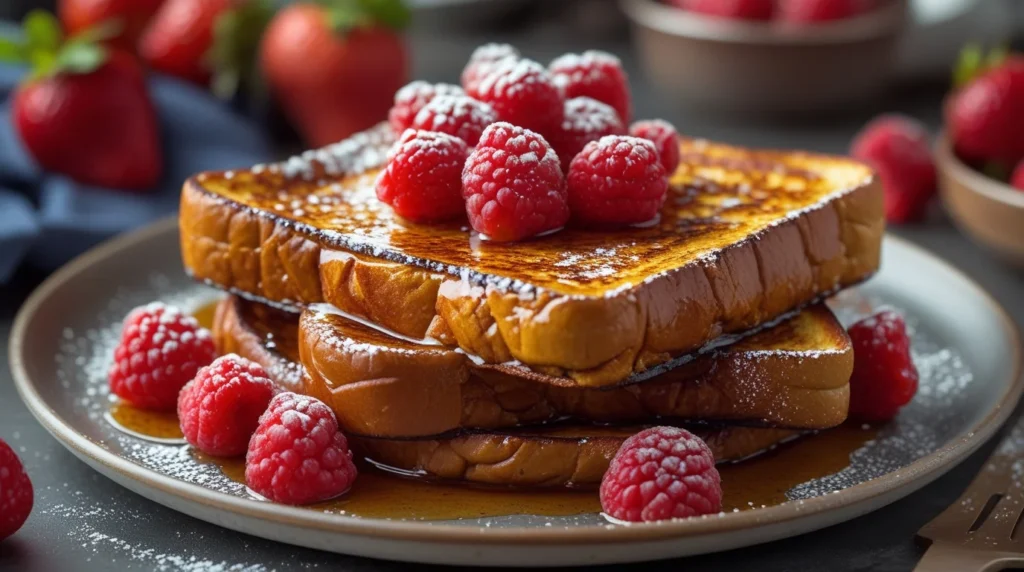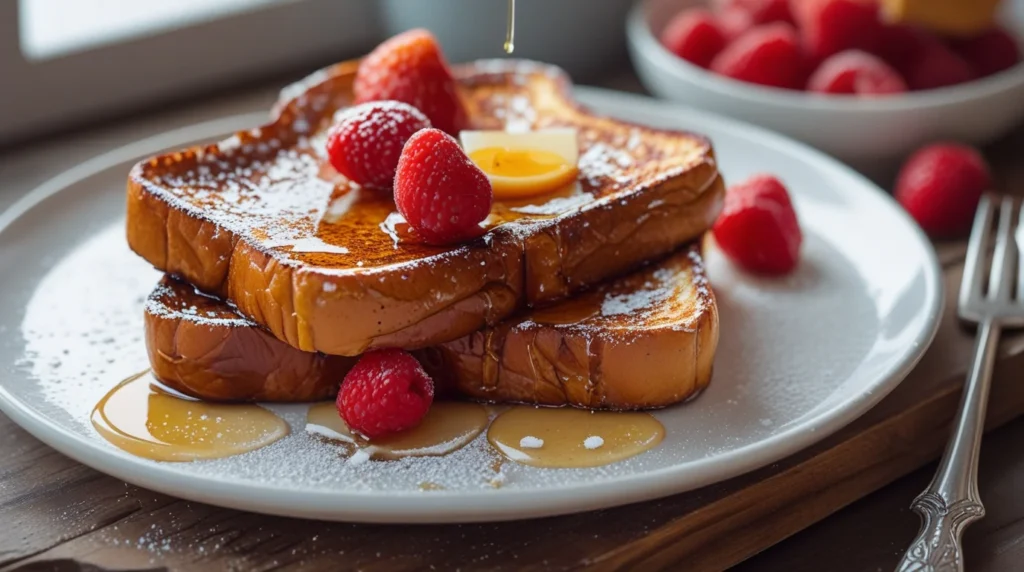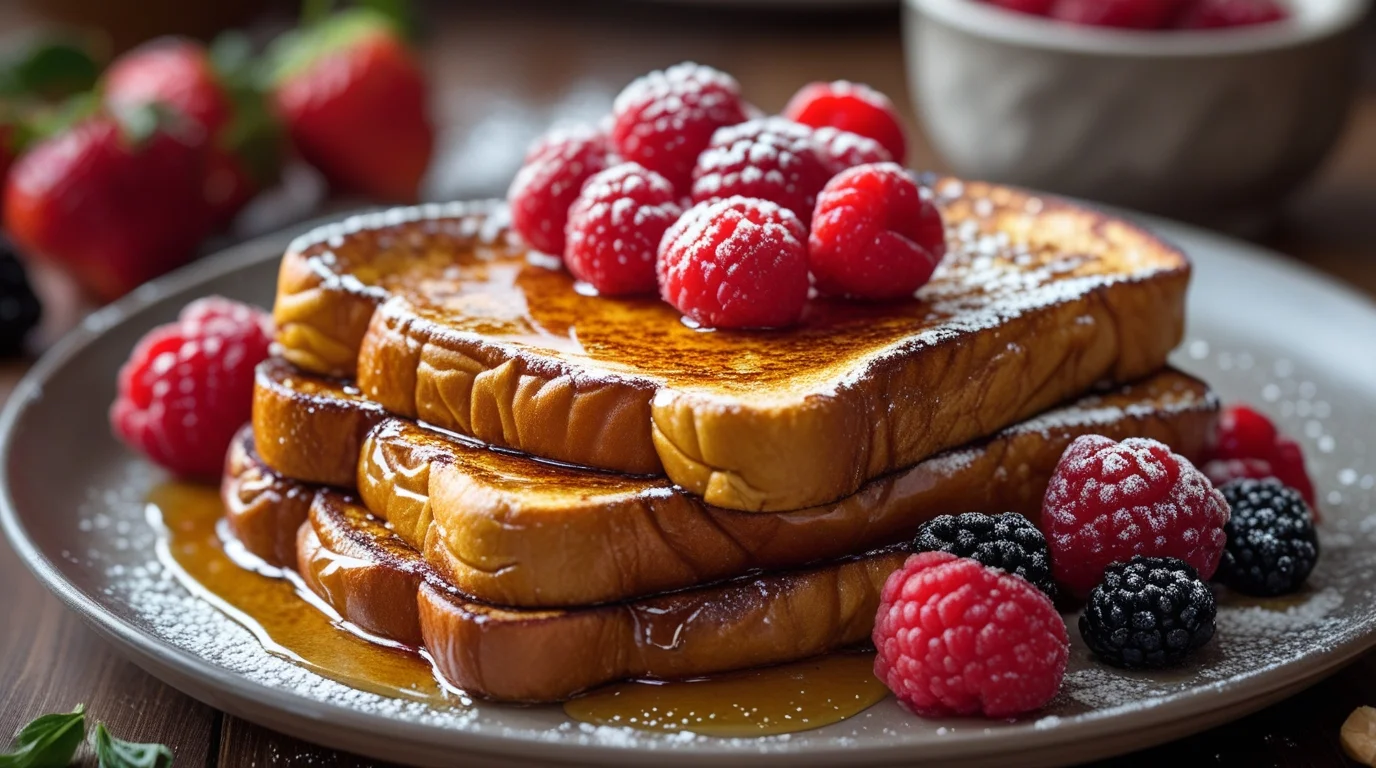Introduction
French Toast is a beloved breakfast classic, cherished for its crispy golden crust and tender, flavorful interior. Known for its simple preparation and rich taste, this dish has become a staple in homes and restaurants worldwide. Its versatility allows for endless customizations, from sweet toppings like maple syrup and berries to savory twists featuring cheese and herbs. Globally, variations of French Toast have emerged, such as France’s Pain Perdu, Hong Kong’s decadent stuffed toast, and Spain’s sweet Torrijas. This universally adored dish offers a perfect blend of comfort and creativity, making it a favorite across cultures and cuisines.

A Brief History of French Toast
The origins of French Toast date back thousands of years to ancient Rome. Known as “Pan Dulcis,” the Romans made this dish by soaking bread in a mixture of milk and eggs, then frying it. This early form of French Toast was a practical way to use up stale bread and avoid waste—a tradition that has carried on in many cultures.
In medieval Europe, a similar dish was enjoyed and referred to as “Pain Perdu,” which translates to “lost bread.” The French name highlights its primary purpose: rescuing bread that was too hard or stale to eat on its own. The practice of reviving old bread by soaking it in a batter and frying it has since evolved into a beloved comfort food enjoyed globally.
Interestingly, the term “French Toast” was popularized in America, though its origins are not strictly French. Over time, the dish became synonymous with breakfast and is now enjoyed in countless variations, from the decadent to the savory.
For a deeper dive into the dish’s history, explore the History of French Toast to uncover how it became a breakfast icon.
The Perfect French Toast: Step-by-Step Guide
Mastering French Toast requires attention to detail and the right combination of ingredients. With these tips, you’ll achieve perfection every time.
Choosing the Best Ingredients
The foundation of any great French Toast is the bread. Opt for:
- Thick slices: Brioche, challah, or sourdough work wonderfully. Their dense, sturdy texture allows them to soak up the batter without falling apart.
- Day-old bread: Slightly stale bread is ideal as it absorbs the mixture evenly and avoids becoming mushy.
The batter is equally important. Create a rich mixture using:
- Eggs and milk: Use whole milk or a blend of milk and cream for a luxurious texture.
- Spices: Add a teaspoon of cinnamon or nutmeg to enhance flavor.
- Optional flavor enhancers: A splash of vanilla extract or orange zest adds a unique twist.
For guidance on crafting the perfect bread base, check out this Brioche Recipe, which works exceptionally well for French Toast.
Step-by-Step Preparation
- Mix the batter: In a shallow bowl, whisk together eggs, milk, and spices. If desired, stir in vanilla extract or orange zest.
- Prepare the bread: Slice the bread into thick pieces, around 1 inch thick. This helps maintain structure during cooking.
- Soak the bread: Dip each slice into the batter, ensuring it is coated evenly on both sides. Let the bread absorb the mixture for 10–15 seconds per side, but avoid oversoaking.
- Heat the skillet: Melt butter in a skillet over medium heat. You can also use a combination of butter and vegetable oil to prevent burning.
- Cook the bread: Place the soaked slices into the skillet. Cook for 2–3 minutes on each side or until golden brown. Adjust the heat to ensure even cooking without scorching.
Pro Tips for Success
- Temperature control: Use medium heat to achieve a crispy exterior without overcooking the inside.
- Butter management: Use just enough butter to coat the skillet. Too much can result in greasy toast.
- Avoid sogginess: If your bread becomes too saturated, it may fall apart. Pat it dry slightly before dipping if needed.

Creative Variations of French Toast
One of the reasons French Toast remains so popular is its adaptability. Here are some creative ways to enjoy it:
Sweet Stuffed French Toast
- Berry Compote Filling: Add cream cheese and a dollop of mixed berry compote between two slices before frying.
- Nutella and Banana: Spread Nutella on one slice and top with banana slices for a decadent twist.
- Ricotta and Honey: Combine ricotta cheese with honey and a hint of lemon zest for a tangy, sweet filling.
Savory French Toast
For a savory option, adjust the batter by omitting sugar and adding herbs or spices:
- Cheddar and Spinach: Layer shredded cheese and sautéed spinach between slices before cooking.
- Ham and Gruyere: Place thinly sliced ham and Gruyere cheese in the middle for a French-inspired take.
- Smoked Salmon and Cream Cheese: Serve your savory French Toast with a topping of smoked salmon, cream cheese, and capers.
Toppings and Serving Suggestions
The toppings you choose can transform your French Toast from simple to extraordinary. Here are some ideas to elevate your dish:
Classic Toppings
- Butter and maple syrup.
- A dusting of powdered sugar.
Fruity Options
- Fresh fruits like strawberries, blueberries, and raspberries.
- Caramelized bananas for added sweetness.
Indulgent Additions
- Whipped cream with a sprinkle of cinnamon.
- Drizzles of chocolate sauce or caramel.
Unique Choices
- A dollop of apple butter or lemon curd.
- Crushed nuts or granola for texture.
If you’re curious about selecting the best maple syrup, check out this Guide to Maple Syrup Grades for insights.
FAQs
What is the trick to good French Toast?
The secret to great French Toast lies in using the right bread, proper batter consistency, and cooking at the correct temperature. Opt for slightly stale, thick-sliced bread like brioche or challah, as it absorbs the batter without falling apart. A well-balanced batter with spices and flavor enhancers, like vanilla or orange zest, adds depth to the dish. Finally, cooking on medium heat ensures a crispy exterior and a soft, fluffy interior.
What is the ratio of milk to eggs for French Toast?
A good rule of thumb is to use a ratio of ¼ cup of milk for every egg. This creates a creamy mixture that evenly coats the bread without being too thin or thick. Adjust the quantity depending on the number of slices you’re preparing.
What is one common mistake when preparing French Toast?
One frequent mistake is oversoaking the bread. While soaking is crucial for absorption, leaving the bread in the batter for too long can result in a mushy texture. Aim for about 10–15 seconds per side, depending on the thickness and type of bread.
How long should French Toast soak?
Bread should soak for 10–30 seconds per side, depending on its density and freshness. Stale bread requires a bit more time, while fresher bread needs less. The goal is for the bread to absorb the batter evenly without becoming overly saturated.
Why is restaurant French Toast so much better?
Restaurants often use high-quality bread, such as brioche or challah, and add extra flavor with spices, vanilla, or even liqueurs like Grand Marnier. They also cook with precision, using just the right amount of butter and maintaining consistent heat for perfect caramelization.
How do I make sure French Toast isn’t soggy?
To avoid soggy French Toast:
Ensure the bread is evenly coated but not dripping with batter before frying.
Use slightly stale bread to prevent excessive absorption.
Limit the soaking time to avoid over-saturation.
Preheat the skillet to medium heat for a crisp crust.
Conclusion
French Toast is a breakfast classic that continues to captivate taste buds around the world. Its origins as a way to rescue stale bread have blossomed into a culinary art form that combines simplicity with endless creativity. Whether you prefer the sweet, buttery goodness of the traditional recipe or the savory appeal of more modern twists, French Toast provides a canvas for flavor and indulgence.
Creating the perfect French Toast involves attention to detail, from selecting the right bread to mastering the batter and frying techniques. With a golden crust and fluffy interior, the dish offers the perfect combination of texture and taste. Beyond the basics, experimenting with variations like stuffed French Toast or adding unique toppings allows you to tailor it to your personal preferences.
Its global appeal, with versions like France’s Pain Perdu or Spain’s Torrijas, reflects the versatility and universal love for this dish. For more breakfast inspiration, try pairing French Toast with Classic Fluffy Pancakes or explore a savory balance by serving it alongside Perfect Scrambled Eggs.
By following the tips and techniques outlined in this guide, you can elevate your French Toast game and bring the magic of a restaurant-quality breakfast to your home. Whether it’s for a casual weekday morning or a special brunch occasion, French Toast promises to be a delicious and memorable start to your day.

